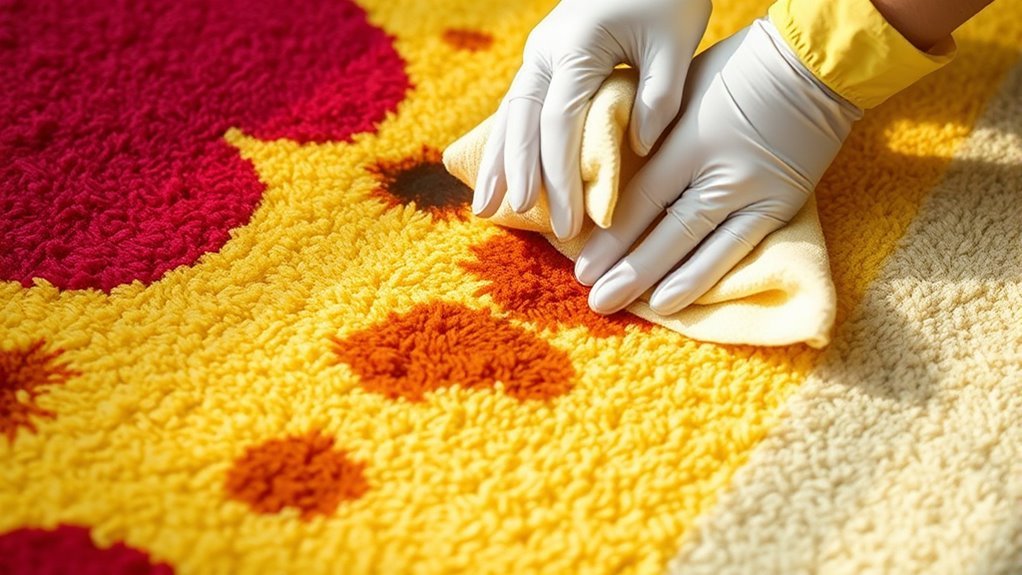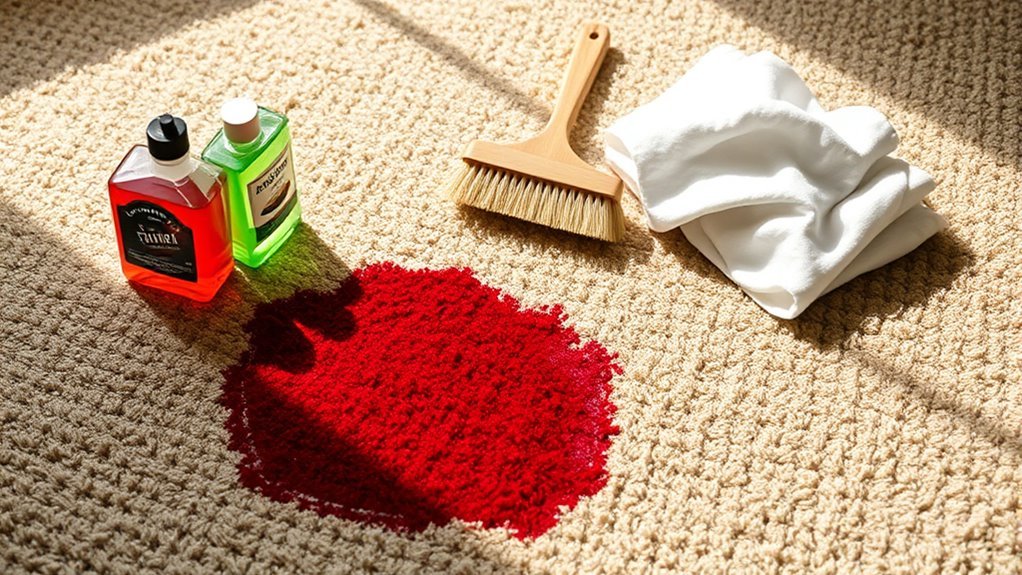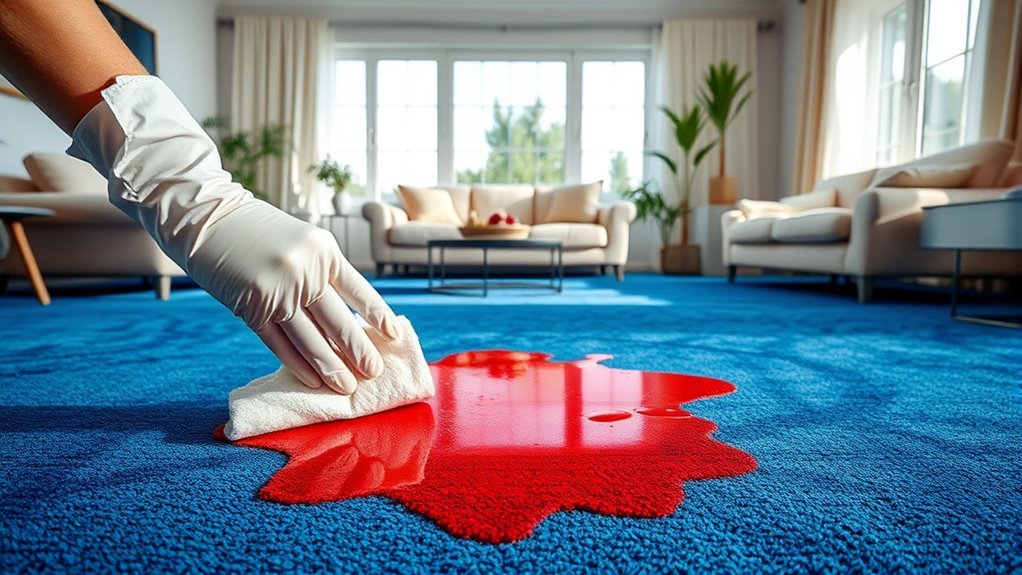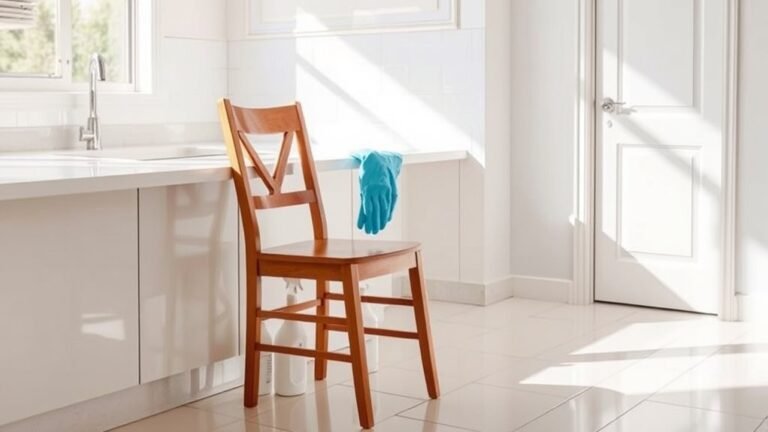Removing Remote Stains From Carpet
To remove remote stains from your carpet, first identify the stain type to choose the right cleaner—water-based, oil-based, protein, or dye stains all need different treatments. Vacuum the area and test your solution on a hidden spot. For set-in stains, pre-treat and gently scrub with a soft brush before blotting with clean water. Don’t forget to tackle hard-to-reach spots using handheld tools. If you want to master stain removal and prevent future issues, there’s more to explore.
Understanding Different Types of Carpet Stains

Although all carpet stains might seem similar at first glance, understanding their different types is essential for effective removal. You’ll find that stain categories generally fall into four main types: water-based, oil-based, protein-based, and dye-based stains. Each type has unique characteristics and requires specific treatment approaches. Water-based stains, like coffee or juice, are often easier to clean but can set quickly if ignored. Oil-based stains, such as grease or makeup, need solvents to break down the oils. Protein-based stains—including blood or sweat—respond best to enzyme cleaners. Dye-based stains, like ink or wine, can be the most challenging because they penetrate deep into fibers. Recognizing these types of stains helps you select the right method, giving you the freedom to tackle carpet messes with confidence and precision. For example, coffee spills leave dark, sticky marks that can penetrate carpet fibers and require prompt attention.
Essential Tools and Cleaning Supplies
Having the right tools and cleaning supplies is essential for effectively removing carpet stains. You’ll need a reliable carpet cleaning solution suited to your carpet type—avoid harsh chemicals that could damage fibers. A clean white cloth or microfiber towel helps prevent color transfer during blotting. A soft-bristle brush assists in gently loosening stubborn stains without harming the carpet. Keep a spray bottle handy for evenly applying cleaning agents, and a vacuum cleaner ready for thorough post-cleaning suction. These tools empower you to tackle stains methodically, ensuring better stain prevention in the future. By having everything prepared and choosing the correct supplies, you maintain control over the carpet cleaning process, preserving your carpet’s appearance and extending its life. Regularly vacuuming high-traffic areas helps reduce dirt and pet hair accumulation, making stain removal easier.
Preparing Your Carpet for Stain Removal

Before you start treating the stain, make certain to clear the area thoroughly and vacuum any loose debris from the carpet fibers. This guarantees that the cleaning solution can work directly on the stain without interference. Always test your chosen cleaning solution on a small, hidden section of the carpet to avoid discoloration or damage.
Clear Area Thoroughly
Start by removing all furniture and objects from the stained area to guarantee you have full access to the carpet. This step is essential, as the carpet location directly affects your approach to stain removal. Clearing the space gives you the freedom to inspect the stain closely and guarantees no obstacles interfere with your work. Once the area is clear, focus on stain identification—knowing the type of stain will guide your cleaning method. Whether it’s a food, ink, or pet stain, recognizing it early prevents spreading and sets the stage for effective treatment. By thoroughly clearing the area, you create an ideal environment to tackle the stain confidently and efficiently, giving you control over the process and protecting the surrounding carpet surface.
Vacuum Loose Debris
One essential step in preparing your carpet for stain removal is vacuuming loose debris thoroughly. Effective vacuum techniques help you capture dust, crumbs, and particles that could interfere with stain treatment. Begin by adjusting your vacuum’s height to match your carpet’s pile, ensuring maximum debris uptake without damaging fibers. Use slow, overlapping strokes to methodically cover the entire area, paying extra attention to corners and edges where debris tends to accumulate. Proper debris management not only improves stain remover effectiveness but also prevents dirt from embedding further. Don’t forget to empty or replace the vacuum bag or canister before starting. By mastering these steps, you maintain a clean surface that allows stain treatments to work efficiently, giving you the freedom to tackle stains confidently and keep your carpet looking fresh.
Test Cleaning Solution
To guarantee your carpet won’t be damaged by stain removers, always test your cleaning solution on a small, hidden area first. This step assures you assess both the test cleaning solution effectiveness and its impact on your carpet fibers.
Follow these precise steps:
- Identify an inconspicuous spot, like under furniture.
- Apply a small amount of the cleaning solution, focusing on test cleaning solution ingredients for potential harshness.
- Wait 10-15 minutes to observe any discoloration or texture changes.
- If no adverse effect appears, proceed to treat the stain confidently.
This methodical approach protects your carpet’s integrity while allowing you the freedom to remove stains effectively. Testing safeguards your investment before full application.
Techniques for Removing Fresh Stains

When dealing with fresh stains on your carpet, acting quickly is essential to prevent them from setting in. Immediate stain removal improves carpet care and preserves your flooring’s look. Begin by blotting the stain with a clean cloth—never rub, as that spreads it. Use a mild cleaning solution suitable for your carpet type, testing first in an inconspicuous spot.
| Step | Action |
|---|---|
| 1. Blot | Use a clean cloth to absorb |
| 2. Apply Cleaner | Use a tested, mild solution |
| 3. Blot Again | Remove loosened stain gently |
| 4. Rinse | Lightly dampen with water |
| 5. Dry | Air dry or blot with towel |
Follow these steps methodically to maintain your carpet’s freedom from stains and extend its life. Using the correct spot treatment techniques tailored to your carpet type can prevent stains from becoming permanent.
Methods to Tackle Set-In and Old Stains
Fresh stains are easier to address because they haven’t set into the fibers yet, but older stains require more targeted approaches. When dealing with set in stains or old stains, you’ll need to be methodical and patient. Here’s how to tackle them:
- Vacuum thoroughly to remove loose dirt before treatment.
- Pre-treat the stain with a commercial carpet cleaner designed for deep stains.
- Gently scrub with a soft brush to work the cleaner into the fibers without damaging them.
- Rinse and blot with clean water to lift residual cleaner and loosened stain, then allow the carpet to dry completely.
Regular maintenance and timely treatment are key, similar to how regular cleaning prevents stubborn stains in dishwashers.
Using Homemade Solutions for Stain Removal
Although commercial cleaners are effective, you might prefer using homemade solutions for stain removal because they’re often safer, cost-effective, and readily available. Homemade cleaners made from natural ingredients like vinegar, baking soda, and lemon juice offer a gentle yet efficient way to lift stains without harsh chemicals. Start by mixing equal parts white vinegar and water in a spray bottle, then apply it to the stain. Let it sit for a few minutes before blotting with a clean cloth. For tougher marks, sprinkle baking soda directly on the stain, spray with the vinegar solution, and allow it to fizz and break down the stain. This method frees you from relying on commercial products, empowering you to restore your carpet with simple, natural ingredients you trust. Regular vacuuming and prompt spot cleaning are essential parts of maintaining carpet cleanliness to prevent stains from setting in.
Commercial Carpet Cleaners: What Works Best
Since homemade solutions might not tackle every stubborn stain, commercial carpet cleaners offer specialized formulas designed for various types of dirt and fibers. When choosing commercial cleaners, you want effective solutions that work without damaging your carpet’s texture. Here’s what to evaluate:
- Enzymatic cleaners for organic stains like food or pet messes.
- Solvent-based cleaners to remove oil or grease effectively.
- Oxygen-based bleach cleaners for brightening and removing tough discolorations.
- Foam cleaners that lift dirt from deep within fibers without overwetting.
Additionally, selecting the right cleaner depends on correctly identifying the stain type, which ensures the most effective treatment.
Tips for Cleaning Hard-to-Reach Areas
Where do you start when cleaning carpet areas that are tough to reach? Focus first on identifying all hard to reach areas such as under furniture, along baseboards, and beneath tight corners. Use specialized cleaning techniques like attaching a crevice tool to your vacuum to extract dirt and debris effectively. For stubborn stains, a handheld steam cleaner or a spray bottle combined with a soft brush can help break down grime without damaging fibers. Always work methodically, tackling one section at a time to guarantee thoroughness. Don’t forget to move lightweight furniture when possible for better access. By applying these precise cleaning techniques, you’ll reclaim those neglected spots, maintaining a fresh carpet and enjoying the freedom of a spotless living space. Remember to vacuum carpet beforehand to lift loose dirt and debris for more effective cleaning.
Preventative Measures to Avoid Future Stains
You can greatly reduce carpet stains by committing to regular maintenance, such as vacuuming and prompt spot cleaning. Applying protective treatments creates a barrier that helps repel spills before they set in. Let’s explore how these preventative steps can keep your carpet looking fresh longer.
Regular Carpet Maintenance
Although accidents happen, regular carpet maintenance can greatly reduce the risk of stubborn stains forming. You’ll find that consistent care not only preserves your carpet’s appearance but also aids in effective stain prevention. Here’s how to keep your carpet in top shape:
- Vacuum frequently to remove dirt and debris before they embed deeply.
- Address spills immediately using appropriate carpet cleaning techniques.
- Use doormats to limit dirt entry and reduce carpet wear.
- Schedule professional carpet cleaning periodically to tackle deep-seated grime.
Protective Treatments Application
Since stains can develop despite regular cleaning, applying protective treatments is a crucial step in safeguarding your carpet. You should use high-quality protective sprays specifically designed to create a barrier against dirt and liquids. These sprays work by repelling moisture and preventing substances from penetrating the fibers, making stain removal easier. When selecting stain repellents, look for products compatible with your carpet material and follow the manufacturer’s instructions carefully. Apply the treatment evenly, allowing it to dry completely before using the carpet. Reapplying protective sprays periodically guarantees ongoing defense. By integrating these preventative measures into your routine, you’ll maintain your carpet’s appearance longer and gain the freedom to enjoy your space without constant worry about accidental spills or stains.
Frequently Asked Questions
How Often Should Professional Carpet Cleaning Be Scheduled?
You should follow frequency recommendations to maintain your carpet’s appearance and longevity. Typically, professional cleaning intervals range from every 6 to 12 months, depending on foot traffic and household conditions. If you have pets or allergies, shorter intervals might be necessary. Sticking to these cleaning intervals guarantees your carpet stays fresh and free from dirt buildup, giving you the freedom to enjoy a clean, healthy living space without constant worry.
Can Carpet Stain Removal Damage Carpet Fibers?
Imagine your carpet as a delicate canvas, where every fiber type reacts uniquely to stain removal techniques. You might worry that aggressive methods could fray or discolor these fibers, and that’s valid. However, when you choose gentle, carpet-specific cleaners and test them first, you minimize damage risk. By understanding your carpet’s material—be it wool or synthetic—you empower yourself to remove stains effectively without sacrificing its texture or appearance.
What Are the Best Carpet Types for Stain Resistance?
When choosing carpets for stain resistance, you’ll want to focus on nylon carpets and polyester carpets. Nylon carpets are durable and resist wear, making them ideal if you need long-lasting protection. Polyester carpets excel at repelling stains due to their hydrophobic fibers, so spills won’t soak in quickly. Both offer you freedom from constant worry about stains, letting you enjoy your space without stressing over accidents or damage.
How Do Humidity Levels Affect Carpet Stain Removal?
When it rains, it pours, and so do humidity effects on stain removal. High humidity means moisture lingers longer, making it tougher to lift stains from your carpet. You’ll want to act quickly and use fans or dehumidifiers to dry the area fast. Low humidity helps stains dry quicker but can set them if you’re not careful. Understanding this balance lets you tackle stains methodically, keeping your freedom to enjoy a clean home.
Are Carpet Stain Protectors Safe for Pets and Children?
When choosing carpet stain protectors, you want to prioritize pet safety and child safety. Many modern products are formulated with non-toxic ingredients, minimizing risks to your loved ones. However, always check labels for certifications or consult manufacturers to guarantee the protector is free from harmful chemicals. Applying the product in well-ventilated areas and allowing it to dry fully can further reduce exposure, helping you keep your home safe and stain-free without compromising health.






